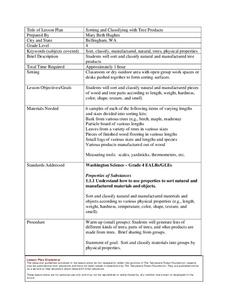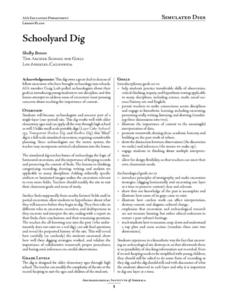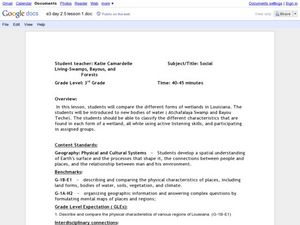Curated OER
Paper Gliders
Sixth graders study friction and drag. In this science lesson, 6th graders use different models of gliders and test to see which of the gliders fly the farthest. Students analyze their data and construct a graph.
Curated OER
Leave No Trace
Students explore what is needed, when preparing for an outdoor trip. In this leave no trace lesson, students examine the equipment required for a camping trip, discuss the hierarchy of needs, and review the seven principles of leave no...
Curated OER
Faraday's Law of Induction
Students study Faraday's law of induction and the equations that show how to calculate electromagnetic induction. In this electromagnetic lesson students complete several experiments on the law of induction.
Curated OER
Face It!
Pupils experiment with proportions and drawing in this excellent Art lesson for grade 5-8. The lesson includes a PowerPoint slide show and requires the use of the educational software entitled "MatchWho". Students are required to use...
Curated OER
Great Blobs of Jelly!
Students explain how zoo-plankton have an impact on the global process. In this ocean zoo-plankton lesson students calculate carbon flux and plankton densities.
Curated OER
Do You Have the Key?
Students practice using a dichotomous key. In this classification lesson, students read an article about scientific exploration and identification of new species. They use a dichotomous key to identify objects and create their own key.
Curated OER
Sorting and Classifying with Tree Products
Fourth graders sort and classify wood. In this sorting tree products lesson, 4th graders sort and classify tree parts and pieces of wood, both natural and manufactured according to their properties.
Curated OER
From Lake to Tap
Middle schoolers use the Internet to study how water is treated to make it safe to drink. They use a tutorial on the U.S. Environmental Protection Agency's website to gain this information. They complete a worksheet for the assessment...
Curated OER
Schoolyard Dig
Learners begin the lesson plan by being introduced to the new vocabulary associated with archaeology. In groups, they use the school grounds to simulate their dig site. They record all the objects they discover and what can be gathered...
Curated OER
Introduction to Topographic Maps
Tenth graders create a topographic map and see how it represents different elevations. In this topographic maps instructional activity students read and interpret topographic maps.
Curated OER
What Is Culture
Fourth graders investigate the concept of culture. They look into the influences that shape culture and how it effects people and regional areas. Students answer the question of why it is important to study culture to have a better...
Curated OER
Good Knight Alphabet Quest
Young scholars will learn new words by using their favorite books. They will examine fiction and nonfiction works to differentiate types of literature. The instructional activity engages learners because it is using the format of a game...
Curated OER
Russian Dolls Investigation
Students measure a set of Russian dolls using the metric system. In this measurement lesson plan, students identify certain relationships between sets of measurements by measuring a set of Russian dolls and presenting their findings to...
Curated OER
Introduction of the Lunar Relief Map Project
Students investigate the geographic features of the surface of the moon. For this lunar relief map lesson, students watch and discuss the Apollo II Moon landing and make preliminary plans for their lunar maps.
Curated OER
Living Swamps, Bayous and Forests
Third graders explore interesting environments by exploring Louisiana. In this wetland lesson, 3rd graders utilize the web to research the State of Louisiana, the bayous in the area, and the Gulf of Mexico. Students write a journal entry...
Curated OER
Map Reading in the 21st Century
Students interact with MapPoint tools to view maps of the past and the present in multiple ways. They participate in mini-lessons aimed at locating certain points of interest or famous routes taken in history.
Curated OER
Air Pollution: Visible and Invisible
Fourth graders work together to complete an experiment on air pollution. They identify visible and invisible forms of pollution. They gather their data in notebooks and analyze their results to end the lesson.
Curated OER
Understanding Topographic Maps
Students are introduced to the characteristics and uses of topographical maps. Using a worksheet, they examine the use of specific terminology and use cutouts to create their own topographical map of an area. They answer discussion...
Curated OER
Junk Mail Jewelry
Students create jewelry from junk mail. In this visual art instructional activity, students use junk mail to design necklaces and bracelets.
Curated OER
Eyewitness Accounts
Students role-play to show the eyewitness accounts of the eruption of Mt. St. Helens. In this volcanic eruption lesson, students act as reporters, eyewitnesses, and scientists to dramatize the eruption of Mt. St. Helens. They discuss the...
Curated OER
NASA's Mars Gamble Pays Off Part 2
Tenth graders explore the planet of Mars. In this Earth Science lesson, 10th graders read articles on the make up of Mars. Students complete a worksheet on their reading.
Curated OER
The Rifting of Pangaea and the Gettysburg Battlefield
Eleventh graders analyze and interpret an animated model of Earth’s rifting processes. For this Earth Science lesson, 11th graders connect Earth’s rifting processes with the Earth’s surface in the Gettysburg battlefield. Students apply...
Curated OER
Ocean Careers Investigation
Students gather information about different careers of the Ocean Adventures expedition team. In this career studies lesson students work in groups, read an interview with an Ocean Adventurer, and see the importance of working in a...
Curated OER
Data Analysis: bird habitats in rice farms
Fifth graders make a graph and write an essay to interpret the data of birds that take advantage of habitats near rice farms. In this data lesson plan, 5th graders calculate the information given to them and interpret it in an essay form.

























